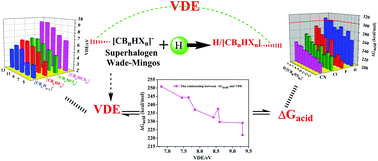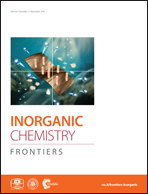Superhalogen-based composite with strong acidity-a crossing point between two topics†
Abstract
The potential of 63 Wade–Mingos-type superhalogens to construct effective superacids via their composites with protons in both gas phase and solution was systematically explored by DFT calculations in this study. With a few exceptions, all the composites prepared herein fulfilled the theoretical criterion for superacid and the predicted strongest acids were consistent with the experimental observations. Based on the analyses of various structural factors, both the increase in cage size and the introduction of electron-withdrawing substituents favor strong acidity. These two factors also lead to high VDE values of the superhalogen component. Further decomposition of the acidity into different contributions verifies that in most cases, particularly those of the strongest acidities, VDE is actually the dominating factor. Thus, there is a clear correlation between the acidity of the entire composite and the VDE of the superhalogen part. This correlation verifies the route of designing a superacid from a superhalogen as a rational approach rather than a coincidence. In this sense, acidity of the composite based on superhalogen is located on the crossing point between two important topics: superacid and superhalogen. The design of novel superacids could eventually be guided by the search for new strong superhalogens.



 Please wait while we load your content...
Please wait while we load your content...